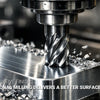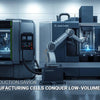How Can Quick Mold Change Systems Cut Die Casting Downtime from 2 Hours to 15 Minutes?

How Can Quick Mold Change Systems Cut Die Casting Downtime from 2 Hours to 15 Minutes?

Every minute your die casting machine sits idle during mold changes costs you money. Right now, thousands of shops worldwide are losing 2 hours or more per changeover, watching three operators struggle with manual bolts while orders pile up. However, a growing number of manufacturers are slashing that downtime to just 15 minutes with die casting quick mold change systems. This dramatic reduction isn't science fiction—it's proven technology that's delivering measurable results across the industry.
Quick Facts: Traditional vs. Quick Mold Change
| Metric | Traditional Method | Quick Mold Change |
|---|---|---|
| Changeover Time | 2+ hours | 15 minutes |
| Operators Required | 3 workers | 1 worker |
| ROI Timeline | N/A | Under 6 months |
| Cost Savings (Annual) | Baseline | $148,000+ |
| Downtime Reduction | Baseline | 87.5% decrease |
| OEE Impact | 65% average | 85%+ achievable |
Key Takeaway: Quick mold change systems can recover your investment in under 6 months while dramatically boosting production capacity and profit margins.
These numbers represent real transformation happening in die casting facilities right now. Moreover, the benefits extend far beyond just saving time. In fact, quick mold change technology is reshaping how manufacturers approach small-batch production, quality control, and overall equipment effectiveness. Therefore, let's explore exactly how this system works and why it might be the smartest investment your shop makes this year.
Table of Contents
- What Makes Manual Mold Changes Your Biggest Cost Drain?
- How Does Hydraulic Clamping Work in Die Casting?
- Can Your Shop Really Achieve 6-Month ROI with Quick Mold Change?
- What Steps Should You Follow When Installing a QMC System?
What Makes Manual Mold Changes Your Biggest Cost Drain?
Opening the Problem
Picture this common scenario: Your production manager gets an urgent order for 500 parts that requires a mold change. Consequently, three experienced operators stop what they're doing, spend 30 minutes just loosening bolts, then another hour carefully aligning the new mold, followed by another 30 minutes torquing everything back down. Meanwhile, your $500,000 die casting machine produces nothing. Additionally, the next shift's production schedule is now completely disrupted.
The Hidden Costs of Manual Changeovers
Manual mold changes drain your profits through multiple channels:
- Machine downtime costs: At $200 per hour, a 2-hour changeover wastes $400 in lost production capacity
- Labor inefficiency: Three operators working for 2 hours equals 6 labor-hours that could be spent on value-adding activities
- Lost production capacity: Those 2 hours could produce 120-200 parts depending on cycle time
- Rejected orders: Long changeover times force you to turn down profitable small-batch work
- Quality inconsistencies: Manual torquing creates uneven clamping force that leads to flash and defects
- Safety risks: Heavy molds and repetitive bolt work increase injury potential
The Deeper Impact on Your Bottom Line
Beyond these immediate costs, manual changeovers create strategic limitations. First, they force you into long production runs to justify the setup time, which ties up capital in inventory. Second, they make your operation inflexible when market demands shift quickly. Third, inconsistent clamping torque from different operators leads to variable part quality, increasing scrap rates by 3-5% on average. Furthermore, the physical strain on workers leads to fatigue-related errors and potential workers' compensation claims. When you calculate the true annual cost of manual changeovers, many shops discover they're losing $200,000 or more in preventable waste.
How Does Hydraulic Clamping Work in Die Casting?
The Technology Behind 15-Minute Changeovers
Hydraulic clamping die casting represents a fundamental shift from sequential manual work to synchronized automation. Instead of three workers spending hours with wrenches, a single operator presses a button that activates multiple hydraulic clamps simultaneously. As a result, what once took 120 minutes now takes just 15. But how exactly does this technology work?
Core Components of a Quick Die Change System
A complete quick die change system consists of four integrated technologies:
- Hydraulic clamping blocks: These replace 24 or more manual bolts with automated clamps that apply consistent, synchronized pressure across the entire mold surface
- Modular bolsters with standardized adapter plates: These allow molds to be prepared, aligned, and preheated on a cart while the machine is still running
- Quick-connect couplings: These link hydraulic lines and cooling channels instantly with a single push-pull motion, eliminating leak risks
- Centralized control system: This coordinates all clamping pressure from one interface, ensuring uniform force distribution
How SMED Principles Drive the Speed Advantage
The dramatic time reduction comes from applying SMED die casting methodology (Single-Minute Exchange of Die). This approach separates changeover tasks into two categories: internal activities that require the machine to be stopped, and external activities that can happen while the machine runs. Traditionally, nearly everything happened internally—heating the new mold, finding the right bolts, aligning components. With quick mold change systems, however, the next mold is preheated, mounted on a standardized bolster, and positioned on a cart during the previous production run. When changeover time arrives, operators simply roll out the old mold assembly and roll in the new one. Then, hydraulic clamps secure everything in seconds with perfect, repeatable force. This synchronized clamping also eliminates the quality problems caused by uneven manual torquing, which often creates flash defects that waste material and require secondary operations to fix.
Can Your Shop Really Achieve 6-Month ROI with Quick Mold Change?
The Numbers Don't Lie
Skepticism about quick mold change investment is understandable—most capital equipment takes years to pay back. However, quick mold change systems are different because they directly eliminate massive, recurring costs every single day. Let's break down the actual QMC ROI analysis with real numbers.
Detailed ROI Calculation Breakdown
Here's how a typical die casting facility with three changeovers per day calculates payback:
Investment Costs:
- Quick mold change system: $40,000–$80,000 (depending on press size and features)
- Installation and training: Typically included in turnkey package
- Total upfront investment: $60,000 (average)
Daily Savings Per Changeover:
- Downtime reduction: 1.75 hours saved × $200/hour machine rate = $350
- Labor savings: 5.5 labor-hours saved × $30/hour = $165
- Quality improvement: 2% scrap reduction = $85 (based on $4,250 material value per run)
- Total savings per changeover: $600
Annual Savings:
- 3 changeovers/day × $600 = $1,800 daily
- $1,800 × 250 production days = $450,000 annually
Payback Period:
- $60,000 investment ÷ $450,000 annual savings = 0.13 years (1.6 months)
Even with conservative estimates, most facilities achieve full ROI within 6 months.
Beyond Time Savings: The Complete Value Proposition
The financial benefits extend well beyond direct cost reduction. First, implementing quick mold change enables OEE improvement die casting operations desperately need. Overall Equipment Effectiveness jumps from industry-average 65% to world-class 85% or higher by dramatically increasing availability (the percentage of time equipment is ready to produce). Second, your facility can now profitably accept small batch die casting orders that were previously unprofitable. When changeover costs drop by 87.5%, jobs requiring just 100-200 parts suddenly become attractive instead of money losers. Third, reduced changeover time means you can respond to customer requests faster, often completing rush orders in days instead of weeks. Additionally, consistent hydraulic clamping eliminates the variation that causes flash, porosity, and dimensional issues, which reduces scrap rates and improves your reputation for quality. Finally, freeing three skilled operators from repetitive bolt work allows them to focus on value-adding activities like process optimization and preventive maintenance.
What Steps Should You Follow When Installing a QMC System?
Your Practical Implementation Roadmap
Knowing the benefits is one thing; successfully implementing a quick mold change system is another. Therefore, let's walk through a proven 5-step deployment plan that minimizes disruption while maximizing results.
The 5-Step QMC Deployment Process
Step 1: Assess Your Current Setup and Requirements
Begin by measuring your press specifications, including platen size, T-slot dimensions, and tie-bar spacing. Additionally, document your current changeover process with video to identify specific bottlenecks. Then, analyze which press has the highest changeover frequency and would benefit most from quick change technology. This assessment typically takes 1-2 weeks and provides the data your supplier needs to design the right solution.
Step 2: Choose a Phased Implementation Approach
Rather than installing systems on all presses simultaneously, start with your most critical machine. This phased approach reduces upfront costs, allows your team to learn the technology gradually, and provides proof-of-concept data to justify expanding to additional presses. Most facilities target their highest-volume automotive or industrial machinery production press first.
Step 3: Partner with an Experienced Supplier for Turnkey Installation
Select a supplier who offers complete support, from initial assessment through installation and training. The best partners will analyze your specific presses, design modular mold design solutions that work with your existing tooling, handle all hydraulic and electrical integration, and provide comprehensive documentation. Furthermore, they should offer ongoing technical support to address any issues during the learning curve.
Step 4: Train Your Operators Thoroughly on Safety and Procedures
Schedule hands-on training sessions that cover proper operation of hydraulic controls, safety protocols for automated mold handling, routine maintenance requirements, and troubleshooting common issues. Importantly, involve your most experienced operators in the training process—they often provide valuable insights that improve procedures. Plan for at least 8-16 hours of training per operator.
Step 5: Monitor Performance Metrics and Continuously Improve
Track key metrics including actual changeover time, setup errors, first-part quality rates, and overall equipment effectiveness. Then, gather feedback from operators about what's working well and what needs adjustment. Use this data to refine your procedures and identify opportunities for further improvement. Most facilities see continuous gains over the first 3-6 months as operators become more proficient.
Overcoming Common Implementation Challenges
Despite careful planning, you'll likely face some obstacles during implementation. First, operator resistance is common—workers who've done manual changeovers for years may be skeptical or worried about job security. Address this by involving them early in the process and emphasizing how the system eliminates the hardest physical work while allowing them to focus on higher-skill tasks. Second, integrating new equipment with existing tooling sometimes requires modifications to your molds or bolsters. Work closely with your supplier to identify these needs during the assessment phase. Third, maintenance requirements differ from traditional setups—hydraulic systems need regular fluid checks and seal inspections. However, establish clear maintenance schedules from day one to prevent unexpected downtime. Finally, measuring success requires tracking the right metrics. Therefore, beyond just changeover time, monitor first-part quality, total production output, and customer delivery performance to capture the full impact. Companies producing precision components through CNC machining or investment casting often find that quick mold change systems complement their existing quality processes by adding consistency and speed.
Conclusion
Quick mold change systems represent one of the most impactful investments die casting manufacturers can make today. By reducing changeover time from 2 hours to just 15 minutes, these systems eliminate massive waste, dramatically improve OEE, and enable profitable small-batch production. Moreover, with typical ROI periods under 6 months, the financial case is compelling even for smaller operations.
The technology works through a combination of hydraulic clamping, modular bolsters, quick-connect couplings, and SMED principles that convert internal setup time to external preparation. As a result, a single operator can now accomplish what previously required three workers and 2 hours of downtime. Furthermore, the benefits extend beyond time savings to include improved part quality, increased production capacity, better workplace safety, and strategic flexibility to respond to market demands.
Implementation requires careful assessment, phased deployment, supplier partnership, thorough training, and continuous monitoring. However, facilities that follow this structured approach consistently achieve dramatic improvements within months. If your shop currently loses hours to manual mold changes, now is the time to calculate your potential savings and consult with quick mold change specialists. The question isn't whether you can afford this investment—it's whether you can afford not to make it while competitors gain speed and flexibility advantages.
Take action today: Document your current changeover process, calculate your annual waste, and reach out to qualified QMC system suppliers to discuss your specific requirements. Your first-year savings might surprise you.
External Links & Resources
[Die casting quick mold change][^1]
[Hydraulic clamping die casting][^2]
[Reduce mold changeover time][^3]
[QMC ROI analysis][^4]
[OEE improvement die casting][^5]
[SMED die casting][^6]
---
[^1]: Explore this link to understand how quick mold change can enhance efficiency and reduce downtime in die casting processes.
[^2]: Learn about hydraulic clamping in die casting to see how it improves precision and control in manufacturing.
[^3]: Explore strategies and techniques to minimize mold changeover time, enhancing efficiency and productivity in your operations.
[^4]: Learn about QMC ROI analysis to understand its impact on investment decisions and operational efficiency.
[^5]: Explore this link to discover effective strategies for enhancing Overall Equipment Effectiveness in die casting processes.
[^6]: Learn about SMED techniques tailored for die casting to reduce setup times and improve efficiency.





